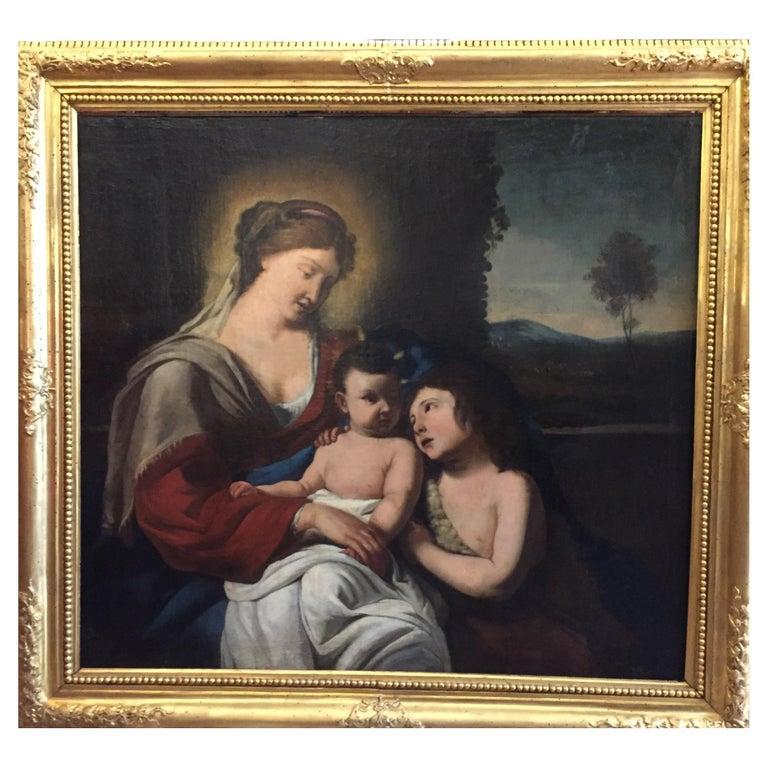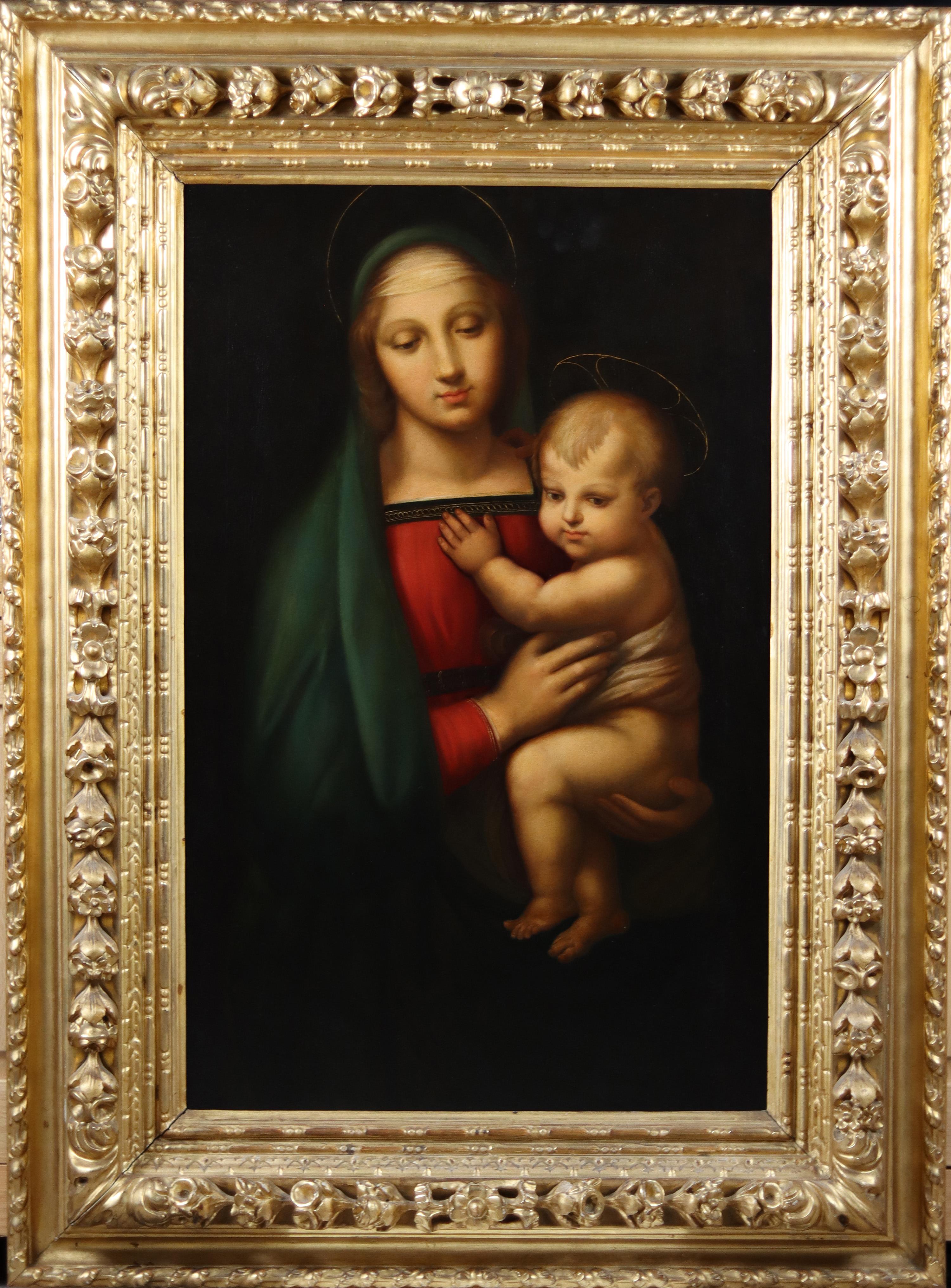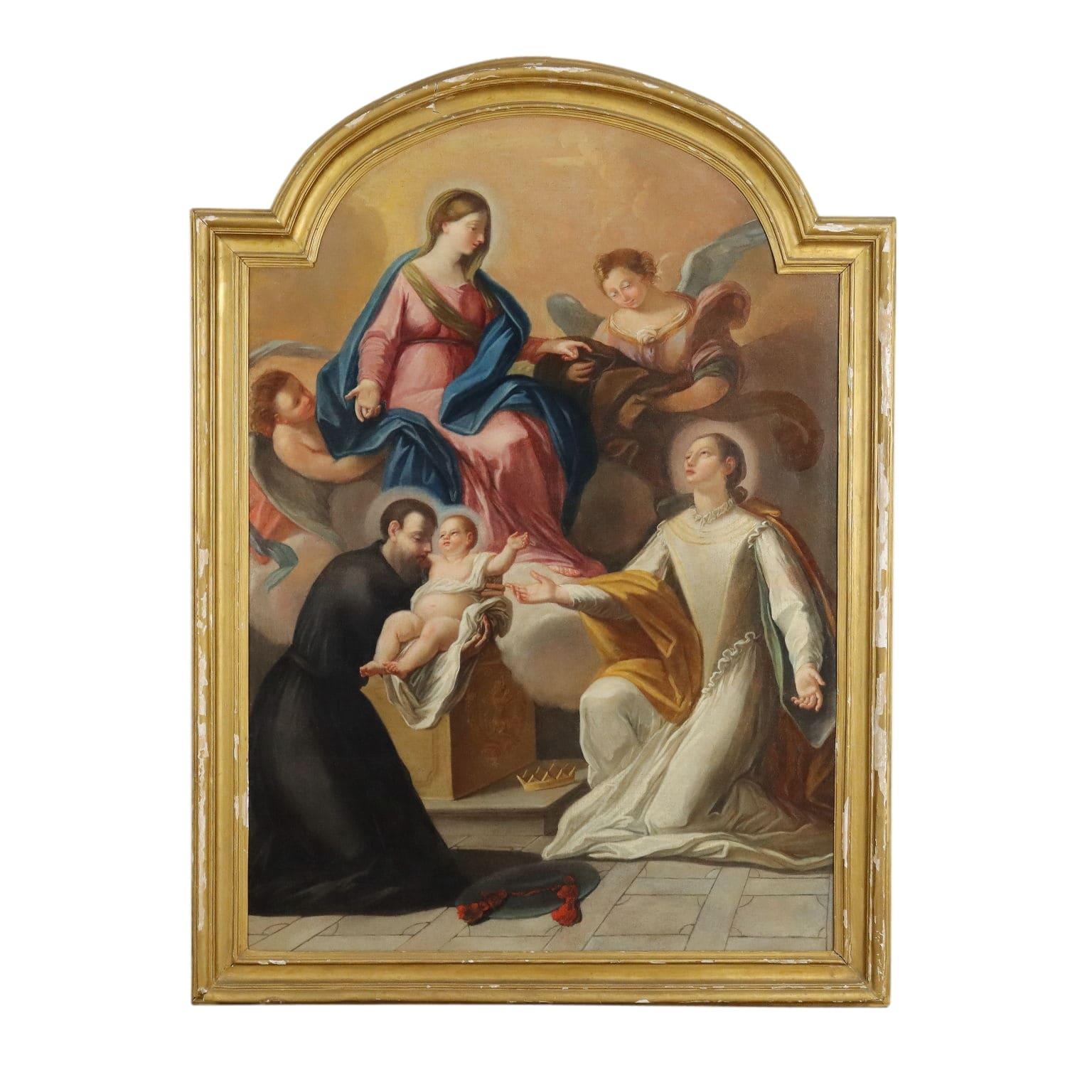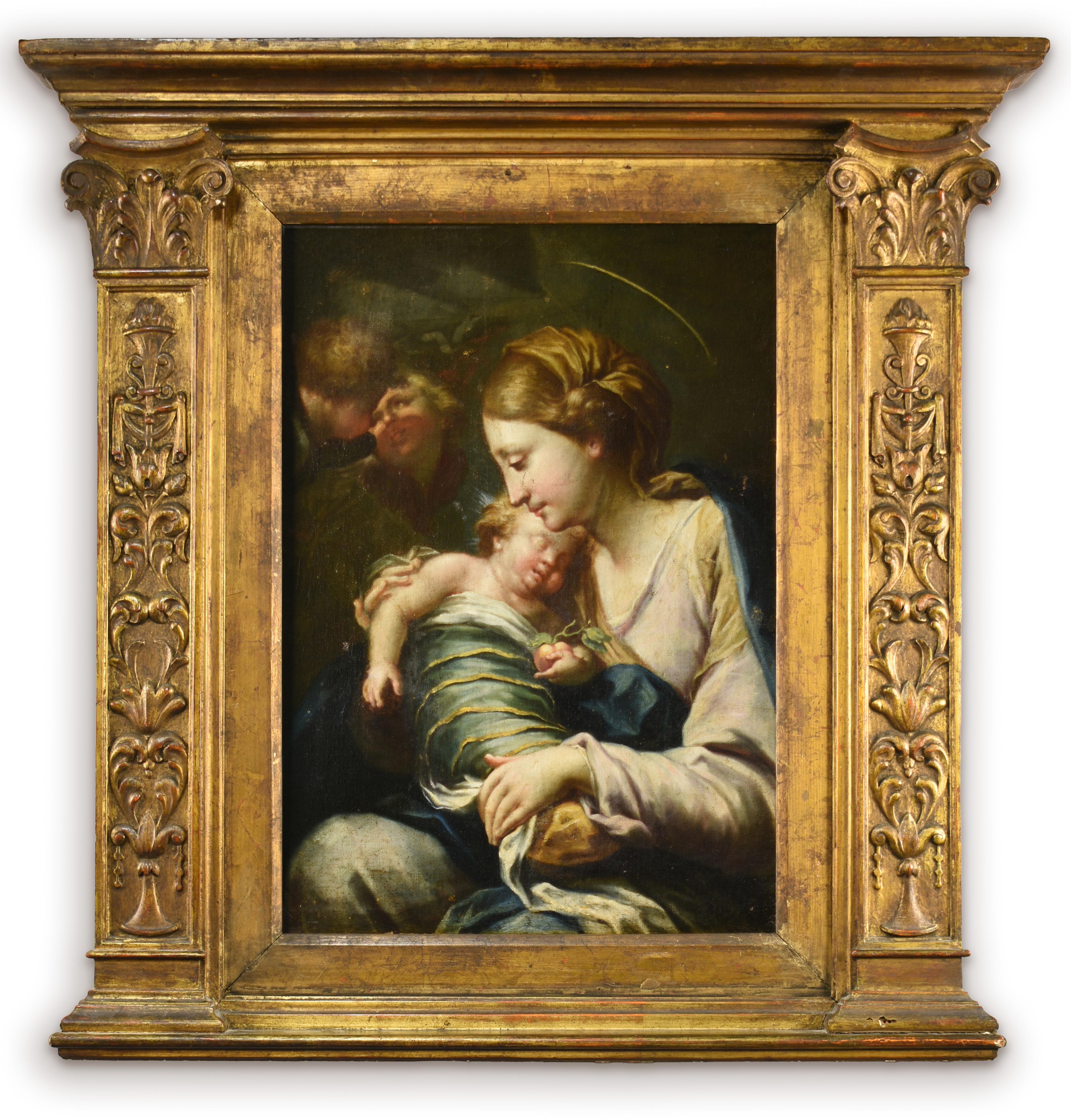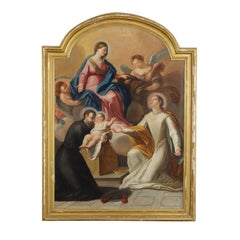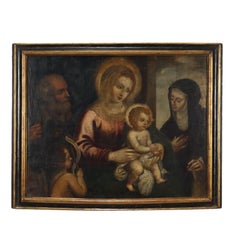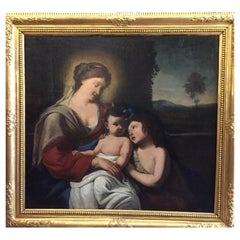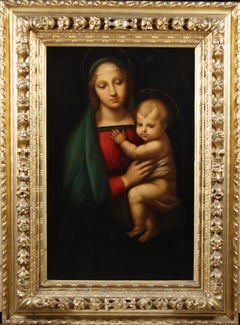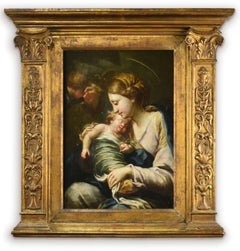Items Similar to Madonna Enthroned with Child between angels and saints Nicholas of Tolentino
Want more images or videos?
Request additional images or videos from the seller
1 of 18
UnknownMadonna Enthroned with Child between angels and saints Nicholas of Tolentino1500s
1500s
$74,111.77
$92,639.7120% Off
£55,551.88
£69,439.8520% Off
€62,400
€78,00020% Off
CA$102,485.46
CA$128,106.8220% Off
A$111,580.53
A$139,475.6620% Off
CHF 59,580.45
CHF 74,475.5620% Off
MX$1,346,951.70
MX$1,683,689.6320% Off
NOK 749,032.80
NOK 936,29120% Off
SEK 696,687.66
SEK 870,859.5720% Off
DKK 475,419.57
DKK 594,274.4620% Off
About the Item
The painting features the enthroned Madonna and Child, two praying angels, and Saints Nicholas of Tolentino, Augustine, Luke the Evangelist, and Monica, below an elegant canopy. The work should be recognized as a preparatory sketch for a large altarpiece, still unknown today. Evidence of this is provided by the panel's measurements, which are not suitable for a church altarpiece or even for a small chapel in a private residence; by the painting, which in some places, such as the two angels on either side of the Madonna and Child or in St. Luke the Evangelist, is deliberately left in a sketchy state; and, finally, by the presence of obvious repentance. One can note in this regard the left arm of the holy bishop, initially thought to be closer to the right arm, and the right hand of the saint. Although the panel is a sketch, one can see details of great pictorial refinement, demonstrating the quality of the painter and the importance that these objects had with respect to the final work: the gold trimmings, for example in the Saint Nicholas of Tolentino, in the loincloth of the little angel in the upper left and in the globe held by the Child, enrich the preciousness of the composition. The somatic features of the figures are outlined at the tip of the brush, while the garments are constructed through more vigorous and less rigorous brushwork, further demonstrating that the work was not to be considered independent. Observe in this regard the cope of the holy bishop, in which we can glimpse figurative decorations-saints or apostles-and an imitation velvet decoration executed with a quick brushstroke that effectively traces only its general outline.
The saints are qualified by a bright palette that particularly highlights the central depiction with the Madonna and Child, St. Augustine, and the angel in the upper right corner. The shadows and lights are studied with special care: the two praying angels are enveloped in the shadows created by the canopy, and accurate are the chiaroscuro effects on St. Luke, St. Monica, and the steps of the throne. The presence of the canopy is a clear legacy of early sixteenth-century Florentine culture: one thinks of the altarpieces by Raphael (Madonna del Baldacchino, Palatina Gallery in Palazzo Pitti, Florence) and Fra Bartolomeo (Pala Pitti, Palatina Gallery in Palazzo Pitti, Florence), from which our painter takes-as was the norm still in the second half of the sixteenth century in Florence-the general composition of the Sacred Conversation.
Marco Collareta is credited with attributing the work to Santi di Tito (Borgo San Sepolcro 1536 - Florence 1603) on the occasion of the celebrated 1980 exhibition: Palazzo Vecchio: Medici patronage and collecting. On that occasion the scholar dated the panel in the mid-1560s, recognizing a close link with the altarpiece fired by the Tuscan painter in 1566 for All Saints in Florence and noting in the painting still "the memory of the chromatic vividness of the frescoes made by the painter during his stay in Rome by 1564" (M. Collareta, 552. Madonna and Child, Angels and Saints, in Palazzo Vecchio: Medici commissioning and collecting, Milan 1980, pp. 283-284)
The presence of the holy bishop Augustine and Augustinian saints Nicholas of Tolentino and Monica leaves no doubt in estimating that the work was commissioned by a community of Augustinians or by a private individual devoted to that order. The Evangelist's presence could be motivated by the dedication of an altar or chapel to that saint, or by the patron whose name must have been Luke. The basilica of Santo Spirito is the home of the Augustinians in Florence and could certainly be a place for which Santi di Tito worked here. Considering how the painter, an absolute protagonist of Florentine and Tuscan painting in the second half of the 16th century, was engaged in different commissions in the Florentine countryside and Tuscany (e.g., in Arezzo, Cortona, and Grosseto) and the widespread diffusion of the Augustinian order in this and other regions, it remains difficult to specify its location.
- Creation Year:1500s
- Dimensions:Height: 34.06 in (86.5 cm)Width: 28.15 in (71.5 cm)Depth: 1.97 in (5 cm)
- Medium:
- Period:
- Condition:
- Gallery Location:Milan, IT
- Reference Number:1stDibs: LU680314080222
About the Seller
4.8
Vetted Professional Seller
Every seller passes strict standards for authenticity and reliability
Established in 2017
1stDibs seller since 2017
126 sales on 1stDibs
Typical response time: 2 hours
- ShippingRetrieving quote...Shipping from: Milan, Italy
- Return Policy
More From This Seller
View AllPainting Madonna and Child 16th century
Located in Milan, IT
Oil on walnut board.
The painting follows early 16th-century Tuscan models (e.g., the pictorial mode of Domenico Puligo), but is of slightly later production and weaker hand, from "p...
Category
16th Century Other Art Style Figurative Paintings
Materials
Oil
$5,510 Sale Price
20% Off
Madonna with Child Angels and Saints, XVII-XVIIIth century
Located in Milan, IT
Oil painting on canvas. Northern Italian school of the 17th-18th century. The work of a devotional nature, sees the Madonna, seated on the clouds and assisted by two angels who suppo...
Category
Late 17th Century Other Art Style Figurative Paintings
Materials
Oil
Dipinto Madonna in Adorazione del Bambino Dormiente XVII secolo
Located in Milan, IT
Olio su tela.
L'opera è una delle numerose repliche, con alcune varianti, del celebre soggetto realizzato dal pittore bolognese Guido Reni (1574 -1642) e dalla sua bottega. La compo...
Category
17th Century Other Art Style Figurative Paintings
Materials
Oil
Painting Holy Family with Saints 17th century
Located in Milan, IT
Oil on Canvas. Venetian school of the 17th century.
The figures, portrayed in the half-length foreground, have Mary placed in the center holding the infant Jesus; behind them on the ...
Category
17th Century Other Art Style Figurative Paintings
Materials
Oil
$3,468 Sale Price
20% Off
Dipinto Sacra Famiglia con Santo Francescano XVII-XVIII secolo
Located in Milan, IT
Olio su tela.
La Sacra Famiglia si rivolge in quest' opera ad un giovane frate in saio francescano, che probabilmente rimanda alla committenza dell' opera: le mani protese del Bambi...
Category
Late 17th Century Other Art Style Figurative Paintings
Materials
Oil
Painting Our Lady of St. Jerome, 17th-18th century
Located in Milan, IT
Oil on Canvas. Emilian school of the 17th-18th centuries.
This is an early copy of Correggio's famous panel painting entitled La Madonna di San Girolamo or Il Giorno (Our Lady of St....
Category
18th Century and Earlier Other Art Style Figurative Paintings
Materials
Oil
$8,028 Sale Price
20% Off
You May Also Like
Madonna With Child and St. John 17th century Italian Lombard School
Located in Milano, IT
Italian religious painting of the Lombard School Madonna and Child with St. John ca. 1650 with a good balanced and harmonious composition in the center of which is the Child with hi...
Category
Mid-17th Century Baroque Figurative Paintings
Materials
Gold Leaf
Madonna del Granduca, after Raphael
Located in West Sussex, GB
"Madonna del Granduca", after Raphael
Oil on Canvas: 34 x 22.5 in. Frame: 45 x 33 ½ in. Inscribed verso.
Pitti Palace red wax seal verso*. Fine Gilt Carv...
Category
Early 17th Century Baroque Figurative Paintings
Materials
Oil
Italian Genovese Madonna. Beautiful frame.
Located in New York, NY
Italian Madonna, early 18th Century, probably Genovese. Beautiful color palette. Not signed.
Category
Early 18th Century Baroque Figurative Paintings
Materials
Canvas, Oil
Madonna and Child- Italian Old Master religious art portrait oil painting
Located in Hagley, England
This superb Italian Old Master religious portrait oil painting is attributed to circle of Bartolomeo Schedoni. Painted circa 1700 it is a half l...
Category
Early 1700s Old Masters Portrait Paintings
Materials
Oil
$6,314 Sale Price
20% Off
Madonna Child Maria Sassoferrato Paint Oil on canvas 17th Century Old master Art
Located in Riva del Garda, IT
Giovan Battista Salvi known as 'il Sassoferrato' (1609 - 1685) circle/ workshop
Madonna with sleeping child
Oil on canvas
84 x 66 cm - Framed (19th century) 112 x 95 cm
The paintin...
Category
17th Century Old Masters Paintings
Materials
Oil
$9,758 Sale Price
20% Off
Oil on canvas, "Madonna and Child" 1850, Eastern Europe
Located in Vicenza, VI
A painting that refers to Our Lady Eleusa, also known as the "Mother of God of Tenderness," which shows an undeniable feeling of affection and tenderness between mother and child. Th...
Category
1850s Other Art Style Portrait Paintings
Materials
Canvas, Oil
